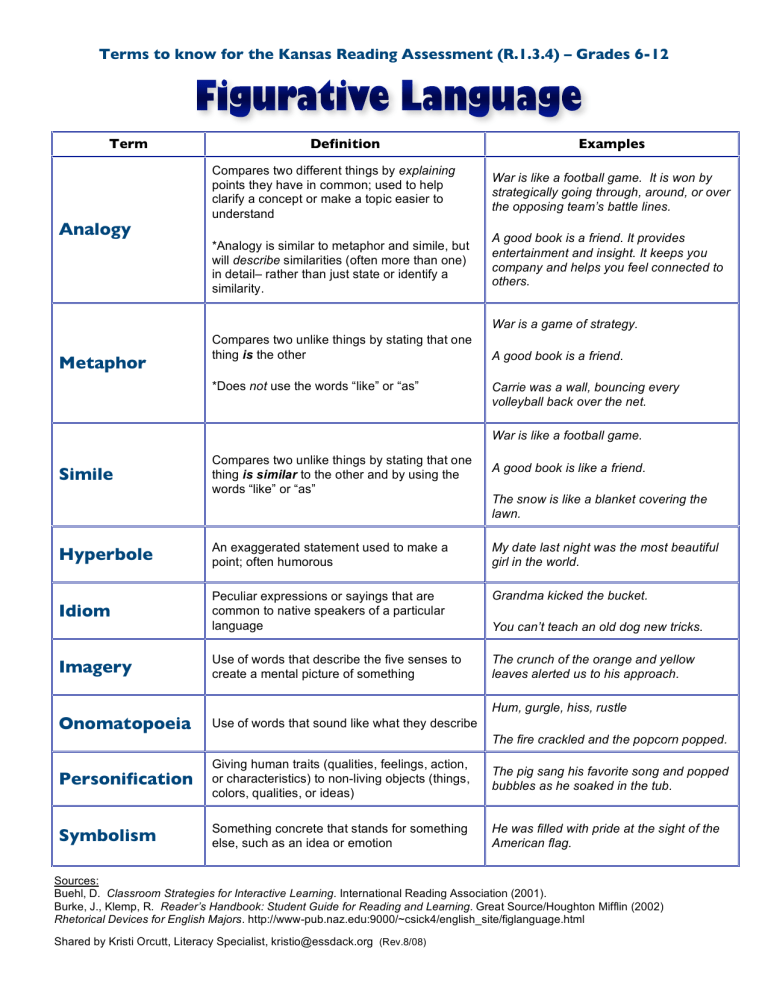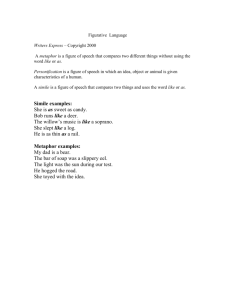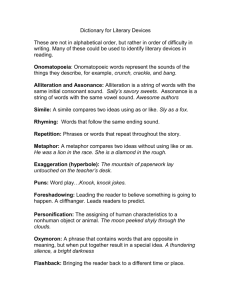Figurative Language: Definitions & Examples (Grades 6-12)

Terms to know for the Kansas Reading Assessment (R.1.3.4) – Grades 6-12
Term
Analogy
Definition
Compares two different things by explaining points they have in common; used to help clarify a concept or make a topic easier to understand
*Analogy is similar to metaphor and simile, but will describe similarities (often more than one) in detail– rather than just state or identify a similarity.
Examples
War is like a football game. It is won by strategically going through, around, or over the opposing team’s battle lines.
A good book is a friend. It provides entertainment and insight. It keeps you company and helps you feel connected to others.
Metaphor
Simile
Hyperbole
War is a game of strategy.
Compares two unlike things by stating that one thing is the other A good book is a friend.
*Does not use the words “like” or “as” Carrie was a wall, bouncing every volleyball back over the net.
War is like a football game.
Compares two unlike things by stating that one thing is similar to the other and by using the words “like” or “as”
A good book is like a friend.
The snow is like a blanket covering the lawn.
An exaggerated statement used to make a point; often humorous
My date last night was the most beautiful girl in the world.
Idiom
Peculiar expressions or sayings that are common to native speakers of a particular language
Grandma kicked the bucket.
You can’t teach an old dog new tricks.
The crunch of the orange and yellow leaves alerted us to his approach.
Imagery
Use of words that describe the five senses to create a mental picture of something
Onomatopoeia
Use of words that sound like what they describe
Hum, gurgle, hiss, rustle
The fire crackled and the popcorn popped.
Personification
Giving human traits (qualities, feelings, action, or characteristics) to non-living objects (things, colors, qualities, or ideas)
The pig sang his favorite song and popped bubbles as he soaked in the tub.
Symbolism
Something concrete that stands for something else, such as an idea or emotion
He was filled with pride at the sight of the
American flag.
Sources:
Buehl, D. Classroom Strategies for Interactive Learning . International Reading Association (2001).
Burke, J., Klemp, R . Reader’s Handbook: Student Guide for Reading and Learning . Great Source/Houghton Mifflin (2002)
Rhetorical Devices for English Majors . http://www-pub.naz.edu:9000/~csick4/english_site/figlanguage.html
Shared by Kristi Orcutt, Literacy Specialist, kristio@essdack.org (Rev.8/08)











